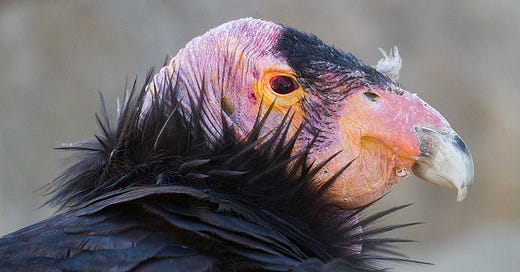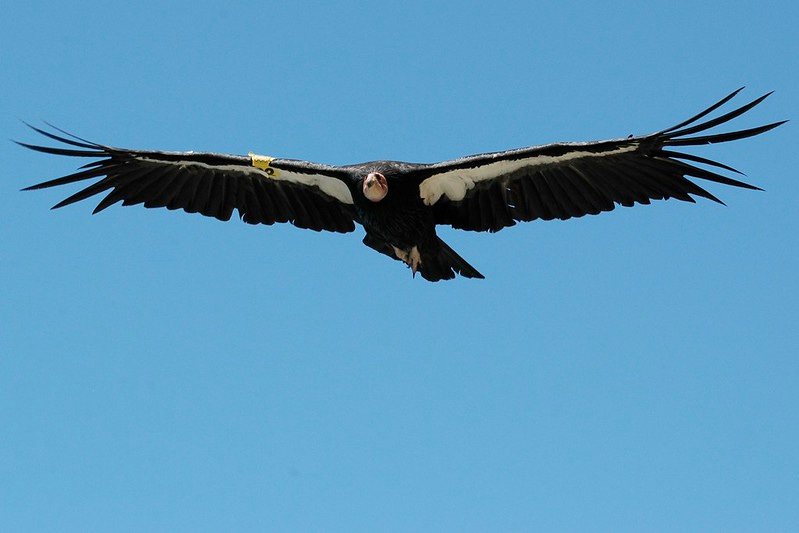Bird of the Week: California Condor
Feast your eyes upon the extremely metal splendor of this enormous, ancient scavenger.
Before we get going, there’s a coincidence at work here that must be acknowledged: Two entries ago, the Bird of the Week was the large and majestic great white pelican, a bird that was wisely suggested by my dad, shepherded by me, and beautifully blogged by Jack. Then, last time, Jack wrote about the teeny tiny burrowing owl and noted in his post that the little guy was an appropriate counterpoint to the previous week’s very big bird. Well friends, we’re now circling back to a big bird and not just any big bird—we’re talking about the biggest flying land birds in the entire Western Hemisphere, and the largest bird in North America. You’ve already seen the photo and read the headline, so yes, that’s right, we’re talking California condors.
Condors are “New World vultures,” which is probably what we should start calling America’s first wave of colonizers, and they have beautifully menacing black feathers except for a streak of white plumage under their wings. It’s giving both goth and dramatic wardrobe reveal at the same time and I’m obsessed. (The Andean condor has more of an Elizabethan ruff vibe with its feathers, which we also have to respect and stan):

Being vultures, condors are carrion eaters, and maintain their massive forms by scavenging dead and decaying animals. And like other vultures, California condors have contrastingly few feathers on their pink head so they can rummage around in those carcasses without too much mess. That said, they are incredibly adaptable creatures and have the ability to raise their neck feathers up to cover their heads when needed. Form and function!
Now, technically the Andean condor has a wider wingspan and is a heavier bird than the California condor, but the California condor wins out in length from beak to tail, averaging at about four feet. And in a truly frightening statistic, their wingspan can be as long as nine-and-half feet (!!!!!!!) and they can weigh as much as 26 pounds (!!!!).
Considering their absolutely behemoth form, it makes sense that California condors are known to some indigenous peoples as 'thunderbirds' and are considered sacred. But they’re a marvel for more than their sick bods. California condors can live for up to 60 years or more and often mate for life. They can also soar for long periods of time while only flapping their wings occasionally (Andean condors literally flap their wings just one percent of the time while in the air!), all thanks to the tips of their wings pointing up, which helps reduce drag and is a feature that’s been used in airplane design. They can soar at speeds up to 40 mph and love to ride the wind as high as 15,000 feet. Look at ‘em go!!!
California condors might be dark, mysterious corpse-eaters, but they’re also sweetie pies who are social and love to hang out with their brethren. Still, they keep it hardcore by nesting on high cliff ledges, in caves, or in the holes of very large trees. They also love to sun themselves and, and will urinate and poop on their own legs to keep cool if those rays become too much. Very punk of them.
Perhaps the gnarliest thing about California condors, or any bird for that matter, is a actually a very recent discovery: they are capable of ‘virgin birth.’ Ahhhhhhhh. Also, speaking from personal experience: I saw a pair of condors at the Grand Canyon last year and they literally took my breath away. Truly, I almost toppled right over from being so stunned by their magnificent presence.
California condors are critically endangered, but there’s some good news: their numbers are up from decades ago due to conservation efforts and greater awareness around lead poisoning, which was killing condors who scavenged from the leftovers of hunting expeditions. And mere days ago, two captive-bred condors were released in Redwood National Park in Northern California. It’s the first time their species has flown those skies since the 19th century. Condors have also recently been released on tribal lands in Northern California as part of repopulation efforts.
I highly recommend turning your brain off and watching this condor cam (or others!) from a wild nest in Big Sur, California:
Part of the struggle to revive condor numbers has to do with their slow reproductive rate—a pair usually only has a single chick every other year. Still, these birds have been around since the Pleistocene era, and have managed to figure out how to live despite the lack of megafauna that once sustained them. They are survivors and they rule!!! I strive to be a scavenger who glides around with very little effort and hangs around for tens of thousands of years. If you have the time, I highly recommend spending a few minutes with this video further explaining why condors are so amazing.
Okay, I’m cutting myself off. I could go on!! If you have a particular fowl that lights your brain on fire, please let us know at hello@discourseblog.com and check out our entire catalog of Birds of the Week. Until then, ponder the condor and let your heart grow fonder for the wild blue yonder. Bye!








“Still, these birds have been around since the Pleistocene era,”…and likely will meet their end because of the selfish, destructive actions of humans.
Other bird related lead news that I swear not a metaphor for anything. https://www.washingtonpost.com/dc-md-va/2022/05/12/bald-golden-eagles-lead-poisoning-populations/